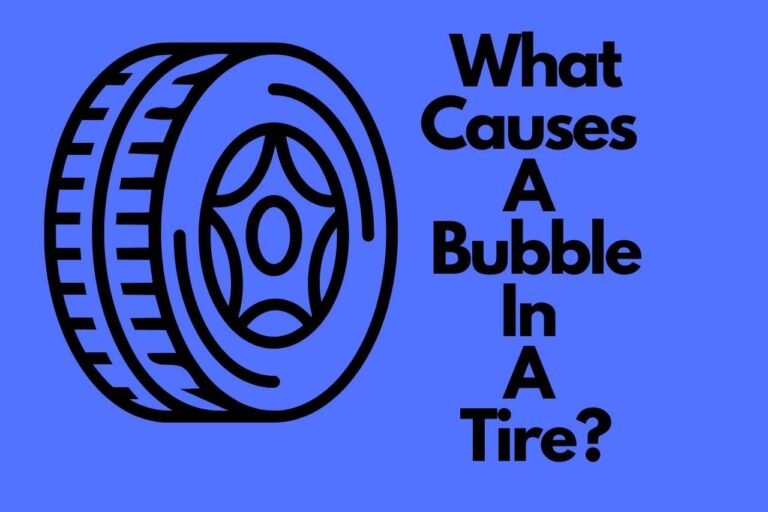Today, we will discuss what causes a bubble in a tire and what you have to do in such a situation. Every automobile owner should check their tires regularly. That isn’t quiet if you have ever spotted a bulge outside your tires. You’ve got to the right place if you’re wondering why a tire has an air bubble.
Irregular damage and cracks are frequent tire problems that can be disastrous if not addressed promptly. This safety issue, often known as a “bubble,” should not be overlooked. If you spot indications of bubbling in your tires, be careful to deal with the issue and immediately work with a tire service specialist.
What Are Tire Bubbles?
Bubbles in the tire’s sidewall are the swellings that form when an impact destroys the inner liner. This impact might produce a rip or tiny holes in the sidewalk plies, weakening their strength. In other words, the generation of a bubble by air escaping from the interior of tires through into the tire’s body.
What Sorts of Tire Bubbles Are There?
Tire bubbles come in two varieties.
-
Tire Sidewall Bubbles
A sidewall bubble is a protrusion that protrudes from the tire’s sidewall. Air escaping from the inner of the tire into the tire’s core causes this.
-
Tire Tread Bubbles
A bulge on the tire tread known as a vehicle tire bubble arises if one of the metal belts that wrap around the tire’s perimeter ends up below or outside the track.
The difference between a tire bubble on the sidewall and a tire bubble on the tread is that a tire bubble on the sidewall isn’t apparent when driving, only when you examine your tires. Bubbles on tire treads, on the other hand, become evident as a result of a certain rhythmic “bumping” when driving.
What Causes A Bubble In A Tire?
What exactly causes a bubble to develop? There are various reasons why such small bulges in automobile tires develop into bumps.
The most common causes of car tire bubbles are listed out below. Impact damage is responsible for any bubbles. When a tire collides with a sharp item on the road, the force of the vehicle’s weight and speed gets concentrated in a narrow contact area.
This pump compresses the tire to the point that the inside sidewall is squeezed and destroyed, resulting in a tiny hole in the inner tire liner layer. The pressure can also destroy the sidewall cables, weakening the tire dramatically. The driver might not be aware of the collision.
-
Potholes
Roads cause damage to the plies of a car’s tire with speed bumps, holes, and other barriers or irregularities. These abnormalities eventually cause the tire layers to separate. Tire bubbles arise due to frequent contact with inevitable speed bumps and potholes.
-
Errors in the manufacturing process
Not all tire bubbles are by contact or collision; in rare cases, bubbles can occur due to internal tire faults, mainly driven by the tire’s manufacturer. Return the tire to the manufacturer depending on your warranty and their rules.
-
Heavy Weight
If your automobile is bearing more load than it used to, bubbles may form on your tire, especially if this happens frequently.
-
Layers of Detached Sidewalls
Tires are constructed by adhering numerous polyester strands to metal sheets and rubber beds. When the layers separate from the tire sidewall, the tire will bubble.
-
Railroad Overpass
Drivers occasionally travel on roadways that have railway lines running through them. If a person drives the rail track course daily, his car’s tires will acquire bumps, eventually turning into bubbles.
-
A worn-out tire cover
The tire is more likely to wear out and break during a collision, indicating that the tire’s metal skeleton can deform. So, when the metal skeleton of the tire dislocates, the result is bubbling.
-
An under-inflated tire
Under-inflated tires generate extreme heat, which leads the intermediate bonding glue to fail and the appearance of bubbles.
-
Icy weather
As an outcome of a temperature drop, vehicles in certain countries frequently experience tire bubbling. Low temperatures in certain areas cause the pressure inside automobile tires to drop. Not addressed, lowered stress in the tire will eventually bubble.
-
Curb has an impact
When a car tire hits a barrier, the barrier and tire wheel pressure the tire, causing a bubble to form. Many of the most prevalent causes of tire bubbles are contact with a curb.
What Causes A Radiator To Crack? You Better Read This First.
Dangers Of A Bubble Tire
The bubble mainly on the exterior indicates that the structure on the interior is breaking. Whatever the source, all will result in a gap between the sidewall layers. When this happens, the bubble might continue to grow, which is dangerous.
A little bubble will develop at first, and the bubbles will grow in size on the other hand. The bubble is a potentially hazardous situation, and a minor speed bump might result in further harm or a catastrophe.
Findings
It’s not the end of the road if you find a sidewall bubble in the tires! Most individuals notice these tiny bubbles in their tires. Still, they don’t take them seriously because they don’t realize the threat they bring to themselves, their vehicle, and everybody else on the road.
Please consider the causes of tire bubbles in vehicle tires to prevent them from recurring. Take the tires to the closest vehicle repair and fix the problem immediately. Do not consider driving the vehicle for an extended period until the issue resolves.
FAQ
How Long Can You Drive with a Tire Bubble?
According to this article, the first and most reasonable plan of action if you have a blown tire is to change it right away. However, if you should drive irrespective of the tire’s condition, you should not exceed 35 mph. Furthermore, avoid excessive braking and acceleration when driving since this may put additional stress on your tire.
Is it Possible to Replace Only One Tire?
In the event of a bubble, we recommend replacing all four tires. Suppose you can’t replace all four tires; couple the substitute with the tire with similar wear. On your automobile, repair both nearby tires. Even so, it’s still a good idea to change all four tires, or at least the two of them.


0 Comments